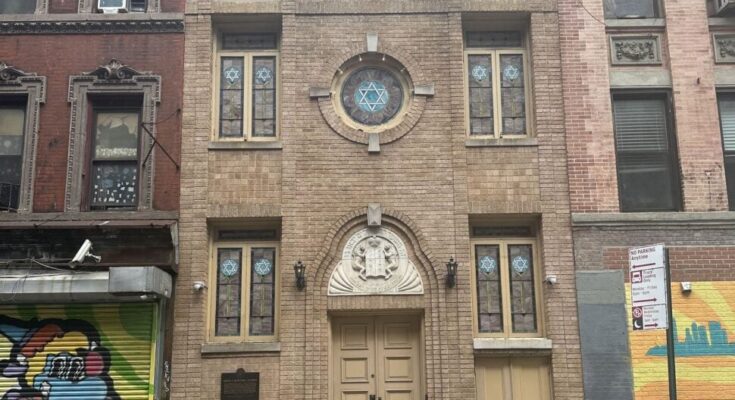
On 280 Broome Street, a quiet subsection of the Lower East Side (LES) of Manhattan, a narrow but ornate Classical and Moorish Revival-style building sits across the street from a photocopy shop and an art gallery: the Kehila Kedosha Janina Synagogue, the only Romaniote synagogue in the Western Hemisphere.
Embellished on the facade of the building (which is a restored, brick version of the original edifice), Stars of David adorn the windows, and the Ten Commandments – in Hebrew – rest high above the doorway, almost anointing visitors as they enter the premises.
The Romaniote congregation, originally from Ioannina, Greece (hence, ‘Janina’ an alternative version of the Greek place-name), formed in 1906, though the synagogue itself was not fully constructed until 1927.
Today, the synagogue is surrounded by bustling Chinese and American businesses, signs in Mandarin and Spanish on neighboring buildings beckon a world that seems almost alien compared to Kehila Kedosha Janina’s Romaniote roots, which some claim extend all the way back to the time of Alexander the Great.
The Kehila Kedosha Synagogue Community Today
Kehila Kedosha Janina (KKJ) continues to be a central hub for the Greek-Jewish community, notably hosting the annual Greek Jewish Festival, which goes viral each year for its celebration of Greek judaism with food and fanfare. KKJ maintains a regular congregation of 20-25 people, and holds Shabbos services every Saturday. However, more people attend the services for the High Holidays, memorials, family reunions and other celebrations.
“This Jewish community is unique because not only are we Greek, but we’re Romaniote,” Andrew Marcus, a Romaniote Greek American who sits on KKJ’s board of trustees, told the Greek Reporter.

“This community spoke Greek at home, unlike the Ashkenazi Jews who spoke Yiddish, or the Sephardic Jews who speak Ladino in Thessaloniki. This community was in Ioannina for centuries before the Sephardic-Spanish jews arrived [in Greece],” continued Marcus. “Beyond a synagogue, we’re also a cultural center.”
KKJ offers more than faith services: concerts, cooking classes, speeches, book presentations, lectures and more. The synagogue is for anyone, including Greek Jews, Romaniotes, Greek Orthodox and people who are simply interested in learning.
The History of the Romaniote Jews in the Lower East Side
The Romaniotes migrated to America following World War I for economic opportunity. Broome, Allen and Orchard Streets, which occupy a northern portion of LES, were home to many immigrant families who left the Ottoman Empire, including Romaniotes who mostly arrived from Greece, the Balkans, Cyprus and modern day Turkey. Hundreds of families who currently attend, or previously attended KKJ, came from Ioannina, but many arrived from Rhodes, Thessaloniki, Istanbul, Izmir, and the former Yugoslavia.
KKJ is what is known as a “tenement” synagogue, according to Marcus. The building was at one point a tenement building, then converted into a Greek coffee shop, and finally a synagogue in 1927. The Romaniote community pooled together money to construct the synagogue, which is much more narrow and space-conscious than other synagogues.


Following World War II, in which many second-or third-generation Romaniotes served the United States armed forces, Lower East Side communities at large migrated elsewhere in the New York Metropolitan Area.
“The first generation [of Romaniotes] lived in tenements, eight people in two-room apartments,” said Marcus, who is a native of the Lower East Side.
“So, with the generation after WWII, they started to move into Brooklyn and The Bronx, eventually to Queens and Long Island and New Jersey.” For a period of time, KKJ had two satellite synagogues in Brooklyn and The Bronx.

“For the most part, the jews that came here from the former Ottoman Empire – Greece – had a relatively positive experience under Ottoman rule and then Greek Christian rule, so, they didn’t come here because of persecution, they came here for economic opportunity,” indicated Marcus.
Jews from the Balkans and surrounding regions often wanted to keep their idiosyncratic traditions alive, so they would establish smaller synagogues like KKJ. At one point, according to Marcus, there were over 400 synagogues in LES.

“Every block had its own synagogue,” he said. KKJ is the only non-Ashkenazi synagogue in the Lower East Side of Manhattan.
The Torah scrolls used at KKJ came from Greece. Their ornate decorations are unique to the Romaniote branch, with glistening silver and gold intricacies reminiscent of Ottoman and Byzantine art styles. The bimah, typically found in front of the Ark (or, Aron Hakodesh), is placed in the center of the synagogue for a more communal listening experience.

The Torah scrolls used at KKJ came from Greece. Their ornate decorations are unique to the Romaniote branch, with glistening silver and gold intricacies reminiscent of Ottoman, Byzantine and Middle Eastern judaica.

KKJ also houses a museum on the Romaniote experience, which includes Judaica like the Alephs, a unique, hand-written birth certificate in Hebrew. The Aleph protects babies for the first 40 days after they are born, including immediate family members’ names, the names of angels, and other religious elements.

Clothing from the early-to-mid 20th century, including Greek-Jewish wedding dresses and textile work, is included in the museum. Many Romaniotes worked in the textile industry because Jewish law necessitates that all fabrics utilized with religiosity be pure, thus incentivizing the Romaniote skill in the fabric arts, as well as gold and silver filigree.
Beyond material Judaica, though, like any Greeks, the Romaniotes love their cuisine. While Kosher, it includes staples like bourekia, spanakopita, lamb and eggplant.
“Anything you can name!” said Marcus. “Except for pastitsio… because of the meat and dairy” (Jewish dietary law prohibits the preparation of meat and dairy in the same utensil or dish).
Literature, history, and even cookbooks are available at Kehila Kedosha Janina – anything the Greek diaspora could hope for.



